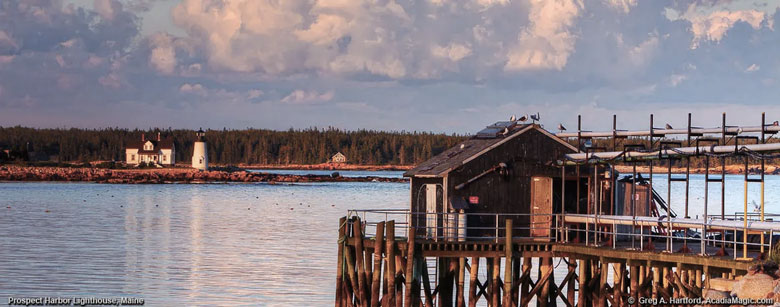Editor’s note: Jacqueline Weaver serves on Gouldsboro’s select board.
When the auctioneer announced the new owners of the former Stinson sardine cannery in the Gouldsboro village of Prospect Harbor, the business partners had a deer-in-the-headlights look. They had just spent more than $1 million (price, plus outstanding liens) for the 100,000-square-foot complex and more than 90 acres, but were not quite sure what they would do with it.
For 135 years, what is known locally as “Stinson’s,” after the name of the founder, was home to a sardine cannery. The last owner was Bumble Bee Seafood, which abruptly closed its doors in June 2010. It was the last remaining sardine cannery in the country.
Two more businesses took over, one after the other. The 40-foot “Big Jim” billboard looming over the property for decades had held a giant can of sardines. It was repainted with Jim hoisting a wooden trap with lobsters—a reflection of those owners’ lobster processing operations.
Maine Fair Trade, the second lobster processor, moved its equipment out several years after purchasing the property in 2012, and focused its attention on a much larger seafood processing operation in New Bedford, Mass.
A single tenant was unlikely. No seafood operation had bid on the complex.
What was looking more and more like a white elephant was purchased in 2022 by American Aquafarms, a company made up largely of Norwegian investors who proposed locating an industrial-scale salmon farm in Frenchman Bay and hatch eggs, process, and transport salmon out of the former Stinson plant site. But the state of Maine had other thoughts. The Department of Marine Resources terminated American Aquafarms’ permit application, citing issues with the source of the eggs and the eggs’ genetic makeup.
On June 15, the property, consisting of a large office space and multiple, cavernous buildings, was auctioned and purchased by three local business people. Tim Ring had owned a paving company. Kevin Barbee and Josh Trundy are in construction. They had collaborated on projects over the years.
The price was $975,000 plus more than $300,000 in liens..
They knew going into the auction that the property was zoned Commercial Fisheries/Maritime Activities, which meant only “functionally water dependent” business could take place within the 11 acres or so on the water.
This meant that the new owners could not, for example, store blueberry boxes—which one potential renter had inquired about.
But they also knew how important the property was to the town of Gouldsboro. People overall wanted to see ongoing business operations on this centrally located, waterfront property in town. They also wanted commerce that was in keeping with the scale of the town.
The partners also hoped the town could help them create a zoning environment that would help pave the way to profitability. A single tenant was unlikely. No seafood operation had bid on the complex.
Planning board members scratched their heads about what could be done with what they feared could remain a ghostly, hulking presence in Prospect Harbor, albeit with multi-million-dollar views.
But Bill Zoellick, a resident who is very active on climate resiliency preparations, and Becky O’Keefe, who had opposed the industrial salmon farm and was hoping an array of small, marine related businesses could fill the buildings, hunkered down and did some investigating.
The town at a special town meeting voted unanimously to change the designated zoning … to keep the site as working waterfront.
Under shoreland zoning, Zoellick said, a town has six options: Resource Protection; Limited Residential; Limited Commercial; General Development I; General Development II, and Commercial Fisheries/Maritime Activities.
After weeks of conversation between Zoellick and the Department of Environmental Protection, the town at a special town meeting in December voted unanimously to change the designated zoning to General Development District I with added restrictions to keep the site as working waterfront. The planning board also included language that prohibits residential use within the designated area and requires that 25 percent of the site be used for marine activities.
General District Development I applies to areas of two or more contiguous acres devoted to commercial, industrial, or intensive recreational activities, or a mix of such activities. Those activities can include, but are not limited to, areas devoted to manufacturing, fabricating or other industrial activities; wholesaling, warehousing, retail trade and service activities, or other commercial activities.
It also includes intensive recreational development and activities, such as, but not limited to, amusement parks, racetracks, and fairgrounds. Areas having patterns of intensive commercial, industrial, or recreational uses are recognized as well.
The matter then went to the DEP for approval. If no word was received in 45 days, the town could consider the new zoning in place.
The deadline for comment passed in March. Suddenly, the white elephant had a future.
The DEP explains in its Maine Shoreland Zoning document that the development of a waterfront management strategy can be a complex process.
“There are many different techniques that can be used to tailor an ordinance to reflect local goals and resources,” it is stated in the shoreland ordinance. “But other zoning variations are also possible which may be much more specific about what types of functionally water-dependent uses should be permitted, make use of more than one type of waterfront district, may include standards for assessing the impact of proposed development on water dependent uses, and may include specific provisions to encourage certain types of public benefits.”





